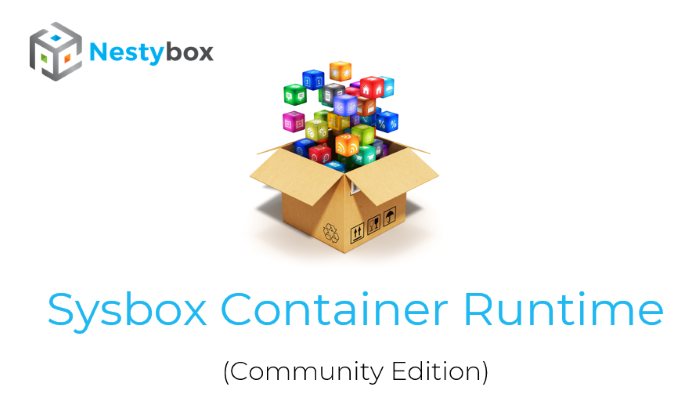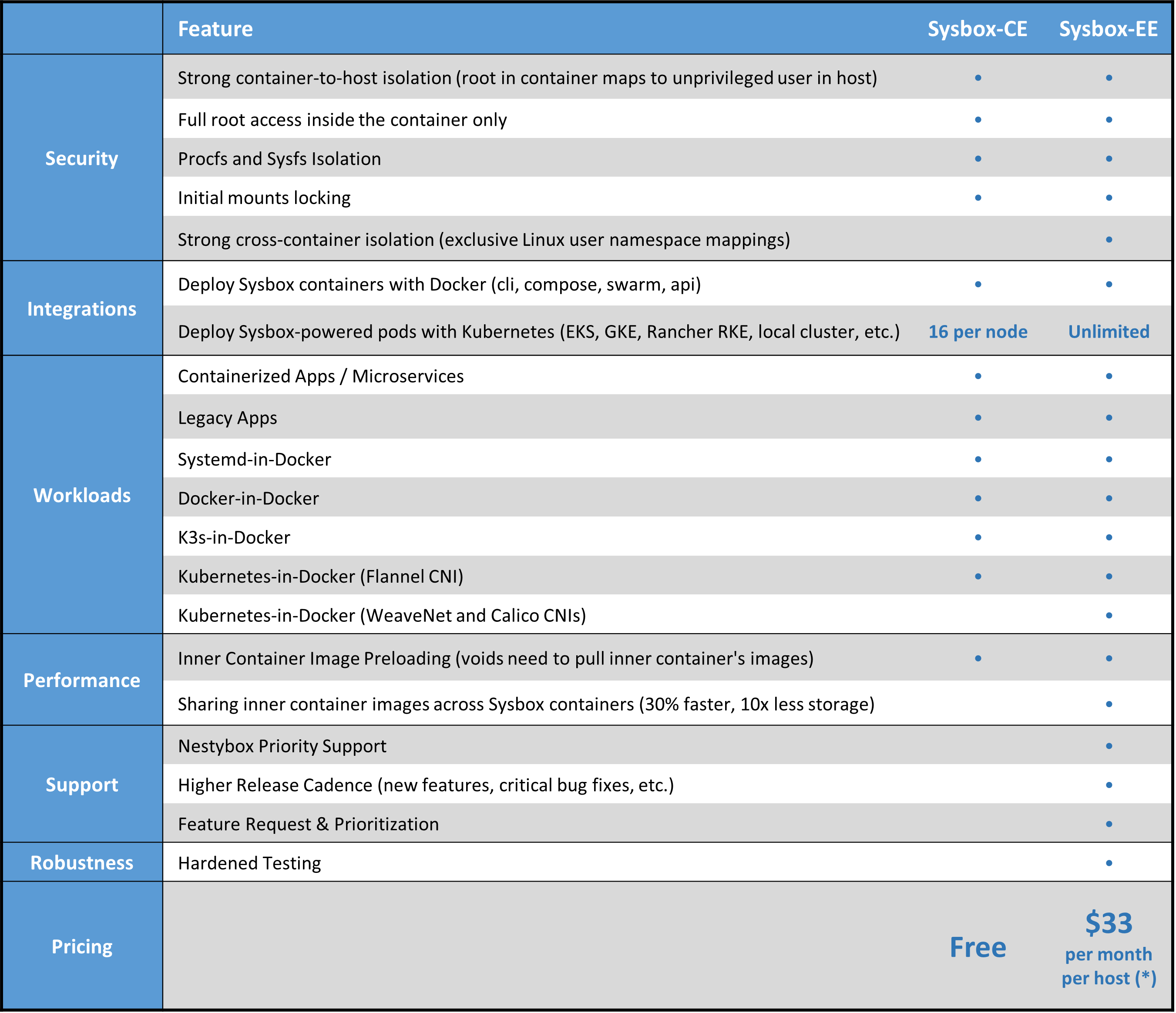Introduction
Sysbox is an open-source container runtime (aka runc), originally developed by Nestybox, that enhances containers in two key ways:
-
Improves container isolation: Sysbox always enables the Linux user-namespace on containers (i.e., root user in the container has zero privileges on the host), hides host info inside the container, locks the container's initial mounts, and more.
-
Enables containers to act as VMs: with Sysbox, containers become capable of running most workloads that run in physical hosts or VMs, including systemd, Docker, Kubernetes, and more, seamlessly and with proper isolation (no privileged containers, no complex images, no tricky entrypoints, no special volume mounts, etc.)
Sysbox is an OCI-based "runc", meaning that you typically use Docker and Kubernetes to deploy these enhanced containers (in fact Sysbox works under the covers, you don't interact with it directly). Thus there is no need to learn new tools or modify your existing container workflows to take advantage of Sysbox. Just install it and point your container manager / orchestrator to it.
For example, this simple Docker command creates a container with Sysbox; you get a well isolated container capable of seamlessly running most software that runs in a VM (e.g., systemd, Docker, etc):
$ docker run --runtime=sysbox-runc -it any_image
Sysbox was forked from the excellent OCI runc in early 2019, and has undergone significant changes since then. It's written in Go, and it is currently composed of three components: sysbox-runc, sysbox-fs, and sysbox-mgr. More on Sysbox's design can be found in the Sysbox user guide.
Demo Videos
Contents
- Motivation
- License
- Audience
- Sysbox Features
- System Containers
- Host Requirements
- Installing Sysbox
- Using Sysbox
- Documentation
- Performance
- Under the Covers
- Comparison to related technologies
- Contributing
- Troubleshooting & Support
- Uninstallation
- Roadmap
- Relationship to Nestybox
- Contact
- Thank You
Motivation
Sysbox solves problems such as:
-
Enhancing the isolation of containerized microservices (root in the container maps to an uprivileged user on the host).
-
Enabling a highly capable root user inside the container without compromising host security.
-
Securing CI/CD pipelines by enabling Docker-in-Docker or Kubernetes-in-Docker without insecure privileged containers.
-
Enabling the use of containers as "VM-like" environments for development, local testing, learning, etc., with strong isolation and the ability to run systemd, Docker, and even kubernetes inside the container.
-
Running legacy apps inside containers (instead of less efficient VMs).
-
Replacing VMs with an easier, faster, more efficient, and more portable container-based alternative, one that can be deployed across cloud environments easily.
-
Partitioning bare-metal hosts into multiple isolated compute environments with 2X the density of VMs (i.e., deploy twice as many VM-like containers as VMs on the same hardware at the same performance).
-
Partitioning cloud instances (e.g., EC2, GCP, etc.) into multiple isolated compute environments without resorting to expensive nested virtualization.
License
Sysbox is an open-source project, licensed under the Apache License, Version 2.0. See the LICENSE file for details.
Audience
The Sysbox project is intended for anyone looking to experiment, invent, learn, and build systems using system containers. It's cutting-edge OS virtualization, and contributions are welcomed.
The Sysbox project is not meant for people looking for a commercially supported solution. For such a solution, use the Sysbox Enterprise Edition (Sysbox-EE).
Sysbox-EE uses Sysbox at its core, but complements it with enterprise-level features for improved security, functionality, and performance, as well as Nestybox support (see next section). It has a 30-day free trial and a paid subscription after that.
For more info on Sysbox-EE, refer to the Nestybox website and the Sysbox-EE repo.
Sysbox Features
The table below summarizes the key features of the Sysbox container runtime. It also provides a comparison between the Sysbox Community Edition (i.e., this repo) and the Sysbox Enterprise Edition (see prior section).
(*) For pricing purposes, a "host" is a computer (bare-metal or virtual-machine) with up to 16 CPU cores (32 hyper threads). Per-core pricing at $5 per-core per-month is also available for hosts with < 8 cores. Licensing is per-year. Volume discounts available for 50+ per-host licenses or 350+ per-core licenses.
More on the features here.
If you have questions, you can reach us here.
System Containers
We call the containers deployed by Sysbox system containers, to highlight the fact that they can run not just micro-services (as regular containers do), but also system software such as Docker, Kubernetes, Systemd, inner containers, etc.
More on system containers here.
Host Requirements
The Sysbox host must meet the following requirements:
-
It must be running one of the supported Linux distros.
-
We recommend a minimum of 4 CPUs (e.g., 2 cores with 2 hyperthreads) and 4GB of RAM. Though this is not a hard requirement, smaller configurations may slow down Sysbox.
Installing Sysbox
The method of installation depends on the environment where Sysbox will be installed:
-
To install Sysbox on a Kubernetes cluster, use the sysbox-deploy-k8s daemonset.
-
Otherwise, use the Sysbox package for your distro.
-
Alternatively, if a package for your distro is not yet available, or if you want to get the latest changes from upstream, you can build and install Sysbox from source.
Before installing, ensure your host meets the host requirements listed in the prior section.
Using Sysbox
Once Sysbox is installed, you create a container using your container manager or orchestrator (e.g., Docker or Kubernetes) and an image of your choice.
Docker command example:
$ docker run --runtime=sysbox-runc --rm -it --hostname my_cont registry.nestybox.com/nestybox/ubuntu-bionic-systemd-docker
root@my_cont:/#Kubernetes pod spec example:
apiVersion: v1
kind: Pod
metadata:
name: ubu-bio-systemd-docker
annotations:
io.kubernetes.cri-o.userns-mode: "auto:size=65536"
spec:
runtimeClassName: sysbox-runc
containers:
- name: ubu-bio-systemd-docker
image: registry.nestybox.com/nestybox/ubuntu-bionic-systemd-docker
command: ["/sbin/init"]
restartPolicy: NeverYou can choose whatever container image you want, Sysbox places no requirements on the image.
The Sysbox User Guide has more info on this, and the Sysbox Quickstart Guide and has many usage examples.
You should start there to get familiarized with the use cases enabled by Sysbox.
Documentation
We strive to provide good documentation; it's a key component of the Sysbox project.
We have several documents to help you get started and get the best out of Sysbox.
-
- Provides many examples for using Sysbox. New users should start here.
-
- Provides more detailed information on Sysbox installation, features and design.
-
Sysbox Distro Compatibility Doc
- Distro compatibility requirements.
-
- Articles on using Sysbox to solve real-life problems.
Performance
Sysbox is fast and efficient, as described in this Nestybox blog post.
The containers created by Sysbox have similar performance to those created by the OCI runc (the default runtime for Docker and Kubernetes).
Even containers deployed inside the system containers have excellent performance, thought there is a slight overhead for network IO (as expected since packets emitted by inner containers go through an additional network interface / bridge inside the system container).
Now, if you use Sysbox to deploy system containers that replace VMs, then the performance and efficiency gains are significant: you can deploy 2X as many system containers as VMs on the same server and get the same performance, and do this with a fraction of the memory and storage consumption. The blog post referenced above has more on this.
Under the Covers
Sysbox uses many OS-virtualization features of the Linux kernel and complements these with OS-virtualization techniques implemented in user-space. These include using all Linux namespaces (in particular the user-namespace), partial virtualization of procfs and sysfs, selective syscall trapping, and more.
The Sysbox User Guide has more info on this.
Sysbox does not use hardware virtualization
Though the containers generated by Sysbox resemble virtual machines in some ways (e.g., you can run as root, run multiple services, and deploy Docker and K8s inside), Sysbox does not use hardware virtualization. It's purely an OS-virtualization technology meant to create containers that can run applications as well as system-level software, easily and securely.
This makes the containers created by Sysbox fast, efficient, and portable. Isolation wise, it's fair to say that they provide stronger isolation than regular Docker containers (by virtue of using the Linux user-namespace), but weaker isolation than VMs (by sharing the Linux kernel among containers).
Comparison to related technologies
Sysbox is pretty unique: it is (to the best of our knowledge) the only OCI-based container runtime that allows Docker and Kubernetes to deploy "VM-like" containers capable of running systemd, Docker, K8s, etc., with ease and strong isolation from the underlying host (i.e., no privileged containers).
See this blog post for a high-level comparison between Sysbox and related technologies such as LXD, K8s.io KinD, Ignite, Kata Containers, rootless Docker, and more.
Contributing
We welcome contributions to Sysbox, whether they are small documentation changes, bug fixes, or feature additions. Please see the contribution guidelines and developer's guide for more info.
Troubleshooting & Support
Refer to the Troubleshooting document and to the issues for help.
Reach us at our slack channel for any questions.
Uninstallation
Prior to uninstalling Sysbox, make sure all containers deployed with it are stopped and removed.
The method of uninstallation depends on the method used to install Sysbox:
-
To uninstall Sysbox on a Kubernetes cluster, follow these instructions.
-
Otherwise, to uninstall the Sysbox package, follow these instructions.
-
If Sysbox was built and installed from source, follow these instructions.
Roadmap
The following is a list of features in the Sysbox roadmap.
We list these here so that our users can get a better idea of where we are going and can give us feedback on which of these they like best (or least).
Here is a short list; the Sysbox issue tracker has many more.
-
Support for more Linux distros.
-
More improvements to procfs and sysfs virtualization.
-
Continued improvements to container isolation.
-
Exposing host devices inside system containers with proper permissions.
Relationship to Nestybox
Sysbox was initially developed by Nestybox, and Nestybox is the main sponsor of the Sysbox open-source project.
Having said this, we encourage participation from the community to help evolve and improve it, with the goal of increasing the use cases and benefits it enables. External maintainers and contributors are welcomed.
Nestybox uses Sysbox as the core of it's Sysbox enterprise product (Sysbox-EE), which consists of Sysbox plus proprietary features meant for enterprise use.
To ensure synergy between the Sysbox project and commercial entities such as Nestybox, we use the following criteria when considering adding functionality to Sysbox:
Any features that mainly benefit individual practitioners are made part of the Sysbox open-source project. Any features that mainly address enterprise-level needs are reserved for the Sysbox Enterprise Edition.
The Sysbox project maintainers will make this determination on a feature by feature basis, with total transparency. The goal is to create a balanced approach that enables the Sysbox open-source community to benefit and thrive while creating opportunities for Nestybox to create a healthy viable business around the technology.
Contact
Slack: Nestybox Slack Workspace
Email: contact@nestybox.com
We are available from Monday-Friday, 9am-5pm Pacific Time.
Thank You
We thank you very much for using and/or contributing to Sysbox. We hope you find it interesting and that it helps you use containers in new and more powerful ways.




